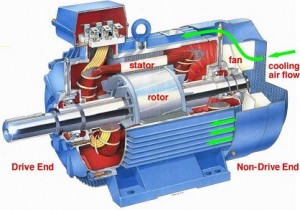Motors are all around us, there in our ceiling fans, our treadmills, refrigerators, clothes dryer, and even the vibrater in your cell phone. Motors constitutes 50% or more of all the energy you use every day. Not all the motors are the same, they come in many different shapes, sizes, and even have a wide range of technology.
There are 3 different types of motors we are going to discuss:
Induction Motor: Induction motors are one of the most popular, most of them run directly off the 60hz AC power that comes out of the wall. They are found in things ceiling fans, clothes dryers, and your central heat/cooling blower. A common induction motor is generally considered to be only 50% efficient, although many induction motors have a very wide range. Some induction motors may reach as low as 15% and as high as 98%.
Brushed DC Motor: Brushed DC motors are very common on battery operated equipment, such as, RC cars and cordless power tools. Brushes are used in this type of motor to get power into the windings as the motor spins, these brushes reduce the efficiency of the motor as it cause ‘shorts’ in the coil as it spins. The brushes also wear out over time and require to be replaced. These motors are not very efficient, generally in the range of 50-70%.
Brushless DC Motor: Brushless DC motors are someone what new to the motor arena. They have electrical components that do the same thing that brushes do on a brushed motor. These motors are seen all over the place, but most recently are taking the stage as part of designing electric cars. These motors can reach very close to 99% efficiency, common ranges are from 70-95% efficiency.
Motor science has picked up over the last decade but was stagnant for many decades before. That has been a great deal in advancement of magnetic and ferromagnetic material that has made this possible.
A word of warning: There have been a lot of publications on “over unity” or “perpetual motion” motors that have been made to “solve our energy needs.” These motor/generators inventor’s are claiming they run/generator power with no energy input or outputting more energy than they are given. These are false. Being a former motor engineer, I have had the opportunity to review many of these claims and all have been fake. Some people have build what they truly believe is real, when in reality they are mistakenly calculating there energy input verse there output incorrectly due to lack of knowledge. Other are simply trying to scam people out of investment money.

Leave a Reply